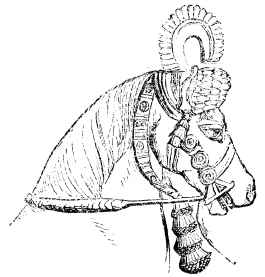762
HARPER'S NEW MONTHLY MAGAZINE.

The speed of horses has always
been a matter of admiration, and is invariably spoken of in the
language of hyperbole. The Orientals use the most beautiful and figurative
expressions when alluding to this subject; they say, “ Horses are
birds which have no wings;” “ For horses nothing is distant;” or, “My
steed possesses the wings of the wind.” Among the more matter-of-fact
people of temperate climates we find equal exaggeration, but expressed in
less poetical phrase. The meaning of “low down in the twenties,” is, if
analyzed, quite as improbable as to say that “for horses nothing is
distant.” The great Anglo-Saxon ideality, however, is to speak of a horse
going a mile in a minute, which is really the absurdest of fictions,
such a feat never having been accomplished, save by Pegasus, or by
the steeds of Phaeton, which dragged the chariot of the
sun.
Before the introduction of
railways the horse was the swiftest mode of conveyance man possessed
; when, therefore, extraordinary distances, within a given space of
time, were made by their assistance, or feats of a remarkable kind were
performed upon their backs, the details were heralded abroad as
“exciting news,” and solemnly recorded among the wonderful events of the
day. Among the famous things particularly remembered is the journey of a
Mr. Thornhill, an innkeeper, of Stilton, in Huntingdonshire, England,
who rode from that place to London, then back to Stilton, then again to
London, making a journey of two hundred and thirteen miles in twenty-four
hours. With the aid of several horses, this man made the same journey in
twelve hours and a quarter. Sir Robert Carey created an intense excitement
in his day by riding three hundred miles in less than three days, when he
went from London to Edinburgh to inform King James of Elizabeth's death.
It is noted by the chroniclers of the time, that the valiant horseman had
several falls, and received many sore braises on the way, which occasioned
his going battered and bloodstained into the “royal presence.” In
more modern times General Lafayette displayed his zeal and strength of
constitution by riding from his head-quarters, Rhode Island, to Boston,
nearly seventy miles, in seven hours, and immediately upon having an
interview with Washington, returning the same journey in six and a
half. On the 3d of May, 1758, a Die Vernon ventured a considerable wager
that she would ride a thousand miles in a thousand hours, and finished the
match in little more than two-thirds of the time. So delighted were the
country people at her success, that they strewed the road she passed along
with flowers. Seventy-five years ago it was very common to make bets upon
riding a long distance “in short time,” by constantly changing horses. In
this way a Mr. Wilde, an Irish gentleman, made himself temporarily famous
by making, over the Kildare course, one hundred and twenty-seven
miles in six hours and twenty minutes, winning a wager of a thousand
guineas. A man named
Nicks (Dick Turpin), having
committed a robbery about four o'clock in the morning, and
fearing detection, “ made for Gravesend, where he was ferried over
the Thames, and appeared the same night at eight o’clock on a
bowling-green in the city of York. Upon his trial he was acquitted,
the jury deeming it physically impossible for the same horse to bear
the same man three hundred
vales in sixteen hours.”
A highly interesting volume might
be written upon the garniture of the horse. It was not customary in
ancient times to shoe his feet with iron, according to our modern
practice, so that a strong hoof, “hard as brass,” and solid “as the
flint,” was reckoned one of the good qualities of the steed. In
Oriental countries the dryness of the soil made an artificial defense
of the hoof less necessary than in the mire and muddy ways peculiar to the
north of Europe. Necessity first suggested the shoeing of horses, and
custom confirmed the practice. There is historical testimony, that before
the use of metal horse-shoes the hoofs of the poor animals became
worn away during fatiguing journeys. When Mithridates was besieging
Cyzicus, he was obliged to dispense with the use of his cavalry, because
the hoofs of his horses entirely wore out. Diodorus Siculus, in speaking
of the army of Alexander the Great, states that on one occasion the
hoofs of the horses had become, by uninterrupted traveling, totally
broken and destroyed. Hannibal's cavalry, which were principally
Numidian, lost all their hoofs in the embarrassing march through the
swampy grounds between Trebia and Fesulae. The ancients had no saddles,
judging from all sculptures that have been preserved, yet they are alluded
to in Leviticus and in Numbers. Many rode without even a bridle, and
thus resembled the Indian tribes of our day, at least in this particular.
The sculptures of Kouyunjik and Khorsabad represent the riders
“bare-backed.” The Elgin marbles are also without saddles; but the
want of these things were more than compensated by other trappings,
particularly of the bridle and reins, which were of extraordinary
splendor. In the bas-reliefs found in Nineveh the trappings of the horses
and chariots are remarkable for their richness and elegance.
Above

HEAD-DRESS OF AN ASSYRIAN
WAR-HORSE.